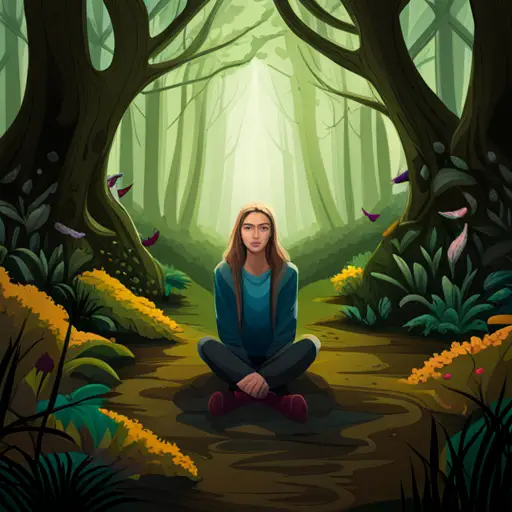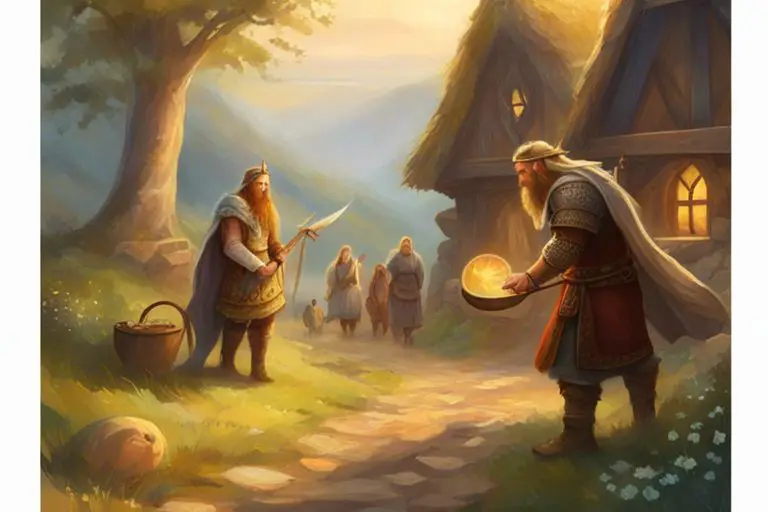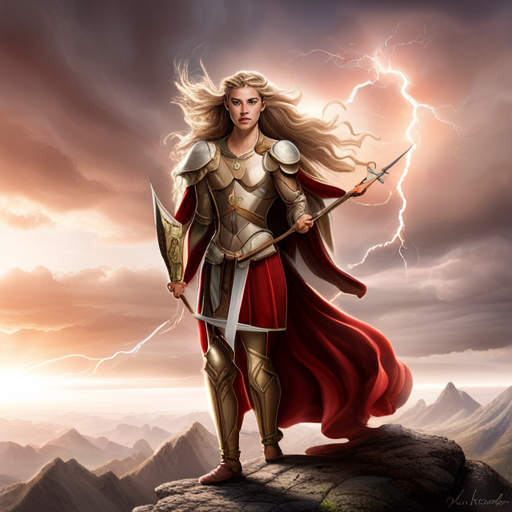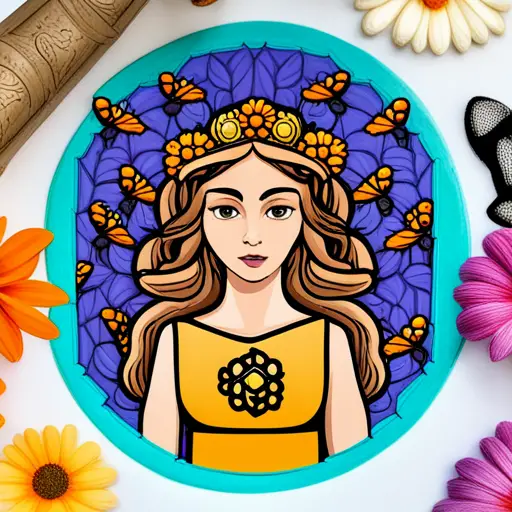I know what you might be thinking, ‘Norse mythology? Isn’t that too dark and complex for kids?’ But let me tell you, Norse mythology is not just for grown-ups or scholars.
It’s a world of enchanting stories, magical creatures, and heroic adventures that can captivate young minds and inspire their imagination.
As a child, I was fascinated by the tales of Thor, Odin, and Loki, and I know many others who share the same fascination.
Norse mythology is not just about violence and gore; it’s about a rich culture and belief system that has shaped the Nordic world for centuries.
And what better way to introduce kids to this fascinating world than through storytelling?
In this article, I’ll take you on a journey through the world of Norse mythology and show you how it can inspire a love for storytelling and mythology in young minds.
So, let’s dive in!
The World of Norse Mythology
You’re about to embark on an exciting journey into the world of gods, giants, and magical creatures that will ignite your imagination and leave you in awe.
Norse mythology is full of enchanting stories that have been passed down from generation to generation. These tales were once told around the fire or in the great halls of Viking warriors, and now, they’re ready to be explored by young minds.
The world of Norse mythology is vast and complex, but it’s also filled with wonder and excitement. It’s a world where gods and goddesses live among mortals, where giants and dwarves forge magical weapons, and where mythical creatures roam free.
It’s a world where the fate of the universe rests on the shoulders of heroic warriors, and where the power of love and friendship can conquer even the strongest of foes.
So, are you ready to dive into this magical realm and meet the gods and goddesses who rule over it? Let’s go!
Meet the Gods and Goddesses
Oh, so you’re here to get the lowdown on those big-shot gods and goddesses, huh? Well, grab a seat and let me tell you all about those divine divas and dudes.
First up, we have Odin, the father of all gods and ruler of Asgard. With his trusty spear, Gungnir, and his two ravens, Huginn and Muninn, he never misses a beat. He’s known for his wisdom and knowledge, having sacrificed one of his eyes to gain the power of foresight. But don’t underestimate him in battle, as he can call upon the mighty Valkyries to aid him.
Next, there’s Thor, the god of thunder and son of Odin. With his hammer, Mjolnir, he can summon lightning and thunderstorms. He’s also known for his incredible strength, which he uses to fight evil giants and monsters. But beneath his tough exterior, Thor has a big heart and is always willing to lend a helping hand.
And let’s not forget his mischievous brother, Loki, the god of trickery. He’s always stirring up trouble, but his cunning and intelligence often save the day.
The Adventures of Thor, Odin, and Loki
Now let me tell ya, you’re gonna love hearing about the wild and crazy adventures that Thor, Odin, and Loki get themselves into.
Thor is known for his strength and power, and he often finds himself in battles with giants and other creatures. One of his most famous adventures is when he went to Jotunheim, the land of the giants, to retrieve his stolen hammer. He had to prove his worthiness by completing a series of challenges, including drinking an entire ocean and lifting a cat that was actually the Midgard Serpent in disguise. In the end, he was successful and returned to Asgard with his hammer, Mjolnir.
Odin, the chief of the gods, is known for his wisdom and knowledge. He often travels the nine realms in search of knowledge and wisdom. One of his most famous adventures is when he sacrificed his eye to gain knowledge of the runes, the ancient symbols of the Norse people. He also has two ravens, Huginn and Muninn, who fly around the world and bring him information.
Loki, the trickster god, is known for his mischievousness and cunning. He often gets himself and others into trouble with his tricks and schemes. One of his most famous adventures is when he shaved off all of Thor’s wife’s hair as a prank, and had to find a way to replace it before Thor found out.
As you can see, these gods and their adventures are full of excitement and danger. But they are also full of magic and wonder.
So let’s move on to the next section, where we’ll talk about magical spells and enchanting creatures.
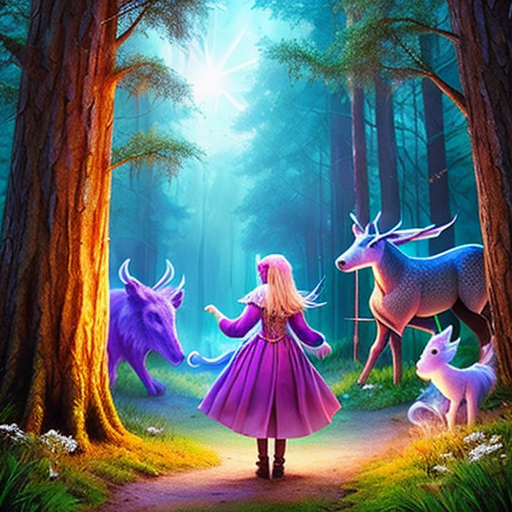
Magical Spells and Enchanting Creatures
Get ready to dive into a world of magic and wonder as we explore the spells and creatures that make the adventures of Thor, Odin, and Loki even more thrilling.
In Norse mythology, magic plays a significant role in the lives of gods and mortals alike. Whether it’s the powerful spells used by Odin to gain knowledge and wisdom or the mischievous tricks played by Loki, magic is always present.
One of the most fascinating aspects of Norse mythology is the array of enchanting creatures that inhabit this world. From the nine realms of Yggdrasil, the world tree, come creatures such as the fearsome Fenrir, the giant serpent Jormungandr, and the beautiful Valkyries.
These creatures add an element of excitement and mystery to the stories and help to create a unique and captivating universe that’s unlike any other.
Inspiring a Love for Mythology and Storytelling
You’ll be inspired to explore the world of magic and wonder through the captivating creatures and powerful spells that bring the adventures of gods and mortals to life.
Norse mythology is a rich tapestry of stories that has enchanted people for centuries, and it’s no wonder why – the tales are full of drama, heroism, and imagination.
As a kid, I was captivated by the exploits of Thor, Odin, Loki, and the rest of the Norse pantheon, and I spent hours poring over books and movies about their exploits.
What I found most inspiring about Norse mythology was the way it encouraged me to use my imagination and creativity. The stories were full of twists and turns, and they challenged me to think beyond the boundaries of my own experience.
As I grew older, I realized that the lessons I learned from Norse mythology had helped shape my love of storytelling and my desire to explore new worlds.
Even now, I find myself drawn back to these tales, eager to discover new insights and perspectives.
If you’re looking for a way to spark your imagination and inspire your love of mythology and storytelling, then Norse mythology is the perfect place to start.
Frequently Asked Questions
What is the historical context of Norse mythology?
To understand the historical context of Norse mythology, it’s important to know that it originated in Scandinavia during the Viking Age, which lasted from the 8th to the 11th century.
During this time, the Norse people were known for their seafaring skills, trading, and raiding. Their mythology was influenced by their daily lives, their interaction with nature, and their belief in gods and goddesses.
The stories were passed down orally until they were eventually written down in the 13th century. Norse mythology provides a fascinating glimpse into the culture and beliefs of the ancient Norse people, and continues to captivate people of all ages today.
How did Norse mythology influence modern literature and popular culture?
When I think about the impact of Norse mythology on modern literature and popular culture, I can’t help but feel a sense of awe.
Like the mighty thunder of Thor’s hammer, the influence of these ancient tales rumbles through our modern world.
From the Marvel Cinematic Universe to Neil Gaiman’s American Gods, the Norse gods and heroes continue to captivate our imaginations and stir our souls.
Their stories offer us a connection to a rich cultural heritage, while also inspiring new tales of heroism, adventure, and magic.
It’s no wonder that so many of us feel drawn to these enchanting stories, seeking a sense of belonging in a world that can sometimes feel disconnected and chaotic.
What are some lesser-known gods and goddesses in Norse mythology?
When it comes to Norse mythology, most people are familiar with the likes of Odin, Thor, and Loki. But did you know that there are numerous other gods and goddesses in the Norse pantheon?
For instance, there’s Heimdall, the watchman of the gods who guards the rainbow bridge that connects Asgard (the realm of the gods) to Midgard (the realm of humans).
Then there’s Freyja, the goddess of love and fertility, who also happens to be a skilled warrior.
And let’s not forget about Hel, the goddess of the dead and ruler of the underworld.
These lesser-known deities may not be as famous as some of their counterparts, but they’re just as fascinating and worthy of exploration.
Are there any significant differences between Norse mythology and other mythologies from around the world?
Comparing Norse mythology to other mythologies around the world is like comparing apples to oranges. Each mythology has its unique set of gods, goddesses, and stories that reflect the culture and beliefs of the people who created them.
However, there are some similarities that can be found across different mythologies, such as the concept of creation, heroism, and the afterlife. In Norse mythology, for example, we have the story of the creation of the world from the body of the giant Ymir, while in Greek mythology, we have the story of the creation of the world from chaos.
Despite these differences, each mythology has something to offer us, whether it’s a sense of wonder, inspiration, or a deeper understanding of ourselves and the world around us.
How did Norse mythology evolve over time and across different regions?
As I delved deeper into the world of Norse mythology, I discovered that its evolution over time and across different regions was quite fascinating.
The earliest forms of Norse mythology can be traced back to the pre-Christian era, where it was largely an oral tradition passed down through storytelling.
Over time, as the Norse people began to settle into different regions of Scandinavia, their myths and legends also began to evolve and adapt to their new surroundings. This resulted in the creation of different versions of the same story, with variations in characters, settings, and themes.
Additionally, the influence of Christianity on Norse mythology can’t be overlooked, as many of the myths and legends were later adapted to fit within a Christian framework.
All of these factors contributed to the unique and complex nature of Norse mythology, which continues to captivate and enchant young minds to this day.
Conclusion
So there you have it, folks! Norse Mythology is a treasure trove of enchanting stories for young minds.
I hope that by sharing some of the adventures of the gods and goddesses, you’ve been inspired to explore this fascinating world even further.
As the ancient adage goes, “A picture is worth a thousand words,” and I believe that storytelling can be just as powerful.
By sharing these stories with our children, we can ignite their imagination and inspire them to create their own tales.
So let’s continue to pass down these magical tales from generation to generation, and keep the world of Norse Mythology alive for years to come.

